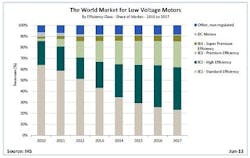ABB Low-Voltage Motors Grow Faster Than the Market
Since ABB's acquisition of Baldor in 2011, the power and automation technology group has improved its position in the low-voltage motors market through continued investments in high-efficiency motor developments and improved customer service.
ABB has increased its sales of low-voltage motors by more than 26% over the last two years. According to its latest report, "The World Market for Low Voltage Motors 2013 Edition," IHS believes ABB is growing faster than the market.
"The strengthening of our market position reflects the successful integration of Baldor in our total offering," says Ulrich Spiesshofer, head of the Discrete Automation and Motion division at ABB. "We are now realizing the synergies that were created by this deal."
By 2017, IHS predicts the market for low-voltage motors to grow to more than $23 billion. The growth is anticipated to be the result of regulatory requirements that stipulate higher motor efficiencies, according to ABB. In 2012, the market size was $14.6 billion – ABB's market share was 14%.
ABB's new synchronous reluctance motors can achieve efficiency levels of IE4 without the use of permanent magnets. The motors reduce energy loss by 40%, compared to the IE2 motor.
"ABB has a strong value proposition and I am happy to see that so many customers appreciate that," said Robert Larsson, manager of ABB's business unit Motors and Generators. "These recent findings by IHS motivate us to press ahead with reducing cost of ownership through customer service and innovation."


